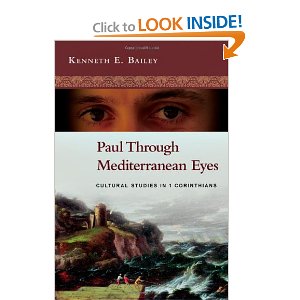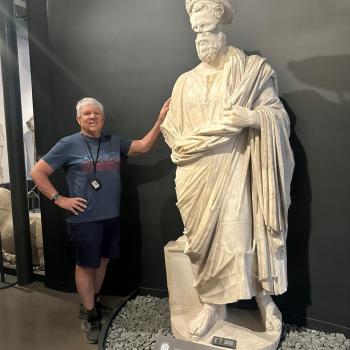The discussion of 1 Cor. 14.33b-36 is unfortunately all too brief. Bailey wants to translate the key verb as ‘chat’ the word simply means ‘speak’ (laleo ) and it is the same word used elsewhere in this same chapter. It is used in contrast with the word silence. The speech is further defined as questions, which are to be asked at home. Bailey thinks the nouns in question refer to husbands and wives, but it is possible they are used more generically of men and women. The key issue is the verb ‘subordinate’ or ‘submit’. The issue is— to what or whom. The context suggests submission to the teaching, for there is nothing in the Law about women being silent in the presence of men, or even in the Torah about women freely submitting to men not even in the creation stories. There are however commands to silence by Paul in this very chapter when a prophet or tongue speaker is speaking. Silence in worship is the issue, and silence when the teaching or prophecy is being offered. This is not about women’s relationships with men or even with husbands in general. It’s about order in worship. One could have wished for Bailey to say a good deal more on this. He does talk about his own experiences of Middle Eastern women who had short attention spans, but that does not help us much, and then he suggests that maybe there was a language issue— but why would there be? This is Corinth, not Jerusalem. Everyone or almost everyone spoke Greek. There is no indication women were asking questions because they couldn’t understand Greek. It is far more likely they were asking questions because that is what you did in the presence of oracles like the one at Delphi.
One of the more interesting points Bailey makes is that at the heart of 1 Corinthians is a discussion in 1 Cor. 8-10 on Christians and pagans, whereas at the heart of Romans is a discussion of Christians and Jews. This does indeed tell us something about the differing concerns each of these letters are dealing with, but what unites them is that it is Gentile Christians in both cases that are causing most of the problems. The discussion about strong and weak in both letters should be compared, though Bailey does not do so.
One of the more interesting bits in 1 Cor. 15.1ff. is the discussion of the Corinthians salvation. He speaks, as Bailey says (pp. 426-27) of salvation in the present tense, and he says that the Corinthians have something to do with. They stand by the grace of God, but they are saved ‘if they hold fast’, and if they don’t they will have genuinely believed, but believed in vain, something Paul is worried about in their case (see 1 Cor. 6). Bailey is likely right that the use of ‘oti’ in the citation of the creedal material indicates a quotation of 4 key phrases about the death and res of Jesus, and as Bailey citing Wright says— this means there was a set tradition about this within a few years of Jesus’ death.
Bailey’s discussion of the creedal statement is helpful, but he also strangely spends a good deal of time trying to minimize the notion of substitutionary atonement (see pp. 431-36). He quote M. Volf to the effect that since Jesus is both God and human he dies for us as God, and he dies as us as a human. The problem with that remark is that God cannot be killed, or to put it more conventionally, is it really the case that Jesus in his divine nature suffered death? Bailey also takes to task Anselm’s work on substitutionary atonement. While it is true that there are some crass ways of looking at this that make it sound like a financial transaction (a certain amount of sin, a certain amount of punishment— a quid pro quo), it really is not helpful to neglect what Paul does emphasis about propitiation and substitution in Romans 3. It is not the only truth about the atonement but it is part of the truth. There is also a rather ineffective parable that Bailey devises to try and explain the meaning of Jesus’ death (pp. 433-35).
The discussion of the resurrection is useful, and one of the more interesting illustrations in the whole book is the story of what happened to the body of Hailie Selasse when the socialists over through his government. The incoming ruler had him buried under the tile floor in his office where he sat, so he would literally have put his enemy underneath his feet. Bailey uses this to illustrate that same phrase which talks about Jesus putting his enemies under his feet (pp. 446-47).
An excellent example of how things go wrong when you read a structure into the text of a Pauline discourse can be found on pp. 348-49 where Bailey argues that Paul’s reference to boasting in the Corinthians and dying daily is said to be a climax of this particular ring composition. In what sense is this exclamation a climax? It does not climax the ‘if the dead are not raised theme’. It does not climax the reference to baptism. It is related to its context by the fact that if there is no resurrection then Paul’s ministry is pointless, but that is all.
On p. 450, Bailey following Thiselton suggests that the phrase ‘baptism for the dead’ means getting baptized in order to join the dead Christians (their relatives) in the afterlife. In other words it means ‘baptism for the sake of joining the dead’. While I consider this possible, it does not take seriously the pagan notion that the living can benefit their deceased ancestors, through some religious act. For example, there was the birthday celebration on the tombs of the ancestor in which they poured wine through a spout into the tomb while they themselves celebrated on the tomb. The phrase ‘baptism hyper the dead ones’ is most naturally taken to mean a baptism that somehow benefits the dead ones directly— hyper requires some unpacking to mean ‘for the sake of joining’ rather than ‘on behalf of’, and so proxy baptism.
Bailey aptly quotes Garland’s commentary on 1 Cor. as saying “Resurrection means endless hope, but no resurrection means a hopeless end—and hopelessness breeds dissipation.” (p. 721). P. 459 is one of the most helpful pages in the whole book. Bailey says this “The reader can see the wisdom of beginning this list with…the parable of the seed. The new plant that arises from the soil is not created out of the vegetable matter found in the seed. Paul is not telling his readers that in the resurrection the sarx (flesh) will magically reform and arise using the same bone and flesh with which it died. … no 21rst century Christian needs to worry les cremation damage the resurrection body.” He then goes on to say Paul uses the term soma in several ways here— a soma which has flesh, a soma as a psychikos a body that is constituted as a living person, and a soma that is constituted by the Holy Spirit (pneumatikos) which he then translates a Spirit-filled body. I do not think Paul uses the term soma itself to refer to the whole person (contra Bultmann), and it would seem better to say that the psychikos/pneumatikos contrast refers to a body with a natural animating principle (life breath) vs. a body totally animated by the Spirit. In any case, Paul is not talking about ‘a spiritual body’ i.e. a body made out of non-material stuff. Bailey rightly rejects the notion that ‘spiritual body’ means a disembodied spirit, or a non-material body. Drawing on some interesting Arabic translations he takes it to mean a body totally directed by (and empowered by) the Spirit (pp. 465-66). Chrysostom speaks of a body totally controlled by the Spirit.
On p. 472, following Thiselton, Bailey rightly notes the scholars who think the phrase ‘we shall not all sleep’ compared to what Paul says in 2 Cor. 5 means that Paul changed his mind about whether he would still be alive when the Lord returns. But as Bailey suggests the ‘we’ here is not those of Paul’s age, but the ‘we’ of all Christians in whatever period of time. When Christ returns, some believers will be alive still on the earth and be changed, and some will be raised from the dead. Paul is not predicting here that he will be in the former camp.
Bishop Bill Frey “Hope is hearing the music of the future. Faith is dancing to it today”. (quoted by Bailey p. 477). Bailey rightly stresses that resurrection is not a call to relax and await the inevitable end of things in victory. Resurrection is a call to arms, to duty, to ministry.













